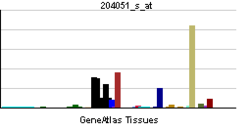SFRP4
| View/Edit Human | View/Edit Mouse |
Secreted frizzled-related protein 4 is a protein that in humans is encoded by the SFRP4 gene.[3][4]
Function
Secreted frizzled-related protein 4 (SFRP4) is a member of the SFRP family that contains a cysteine-rich domain homologous to the putative Wnt-binding site of Frizzled proteins. SFRPs act as soluble modulators of Wnt signaling. The expression of SFRP4 in ventricular myocardium correlates with apoptosis related gene expression.[4]
SFRP4 is a hub gene in a Type 2 Diabetes-associated gene coexpression module in human islets, and reduces glucose-induced insulin secretion through decreased β-cell exocytosis. Expression and release of SFRP4 from islets is enhanced by interleukin-1β. SFRP4 is elevated in serum several years before clinical diagnosis of Type 2 Diabetes. Individuals who have above-average levels of SFRP4 in the blood are five times more likely to develop diabetes in the next few years than those with below-average levels.[5]
References
- ↑ "Human PubMed Reference:".
- ↑ "Mouse PubMed Reference:".
- ↑ Abu-Jawdeh G, Comella N, Tomita Y, Brown LF, Tognazzi K, Sokol SY, Kocher O (May 1999). "Differential expression of frpHE: a novel human stromal protein of the secreted frizzled gene family, during the endometrial cycle and malignancy". Lab Invest. 79 (4): 439–47. PMID 10211996.
- 1 2 "Entrez Gene: SFRP4 secreted frizzled-related protein 4".
- ↑ Mahdi T, Hänzelmann S, Salehi A, Muhammed SJ, Reinbothe TM, Tang Y, Axelsson AS, Zhou Y, Jing X, Almgren P, Krus U, Taneera J, Blom AM, Lyssenko V, Esguerra JLS, Hansson O, Eliasson L, Derry J, Zhang E, Wollheim CB, Groop L, Renström E, Rosengren AH (November 2012). "Secreted Frizzled-Related Protein 4 Reduces Insulin Secretion and Is Overexpressed in Type 2 Diabetes". Cell Metabolism. 16 (5): 625–633. doi:10.1016/j.cmet.2012.10.009.
Further reading
- Rattner A, Hsieh JC, Smallwood PM, et al. (1997). "A family of secreted proteins contains homology to the cysteine-rich ligand-binding domain of frizzled receptors.". Proc. Natl. Acad. Sci. U.S.A. 94 (7): 2859–63. doi:10.1073/pnas.94.7.2859. PMC 20287
 . PMID 9096311.
. PMID 9096311. - Wolf V, Ke G, Dharmarajan AM, et al. (1998). "DDC-4, an apoptosis-associated gene, is a secreted frizzled relative.". FEBS Lett. 417 (3): 385–9. doi:10.1016/S0014-5793(97)01324-0. PMID 9409757.
- Schumann H, Holtz J, Zerkowski HR, Hatzfeld M (2000). "Expression of secreted frizzled related proteins 3 and 4 in human ventricular myocardium correlates with apoptosis related gene expression.". Cardiovasc. Res. 45 (3): 720–8. doi:10.1016/S0008-6363(99)00376-4. PMID 10728394.
- Strausberg RL, Feingold EA, Grouse LH, et al. (2003). "Generation and initial analysis of more than 15,000 full-length human and mouse cDNA sequences.". Proc. Natl. Acad. Sci. U.S.A. 99 (26): 16899–903. doi:10.1073/pnas.242603899. PMC 139241
 . PMID 12477932.
. PMID 12477932. - Berndt T, Craig TA, Bowe AE, et al. (2003). "Secreted frizzled-related protein 4 is a potent tumor-derived phosphaturic agent.". J. Clin. Invest. 112 (5): 785–94. doi:10.1172/JCI18563. PMC 182208
 . PMID 12952927.
. PMID 12952927. - Wissmann C, Wild PJ, Kaiser S, et al. (2003). "WIF1, a component of the Wnt pathway, is down-regulated in prostate, breast, lung, and bladder cancer.". J. Pathol. 201 (2): 204–12. doi:10.1002/path.1449. PMID 14517837.
- Horvath LG, Henshall SM, Kench JG, et al. (2004). "Membranous expression of secreted frizzled-related protein 4 predicts for good prognosis in localized prostate cancer and inhibits PC3 cellular proliferation in vitro.". Clin. Cancer Res. 10 (2): 615–25. doi:10.1158/1078-0432.CCR-0707-03. PMID 14760084.
- Gerhard DS, Wagner L, Feingold EA, et al. (2004). "The status, quality, and expansion of the NIH full-length cDNA project: the Mammalian Gene Collection (MGC).". Genome Res. 14 (10B): 2121–7. doi:10.1101/gr.2596504. PMC 528928
 . PMID 15489334.
. PMID 15489334. - Ahn J, Chung KS, Kim DU, et al. (2005). "Systematic identification of hepatocellular proteins interacting with NS5A of the hepatitis C virus.". J. Biochem. Mol. Biol. 37 (6): 741–8. PMID 15607035.
- He B, Lee AY, Dadfarmay S, et al. (2005). "Secreted frizzled-related protein 4 is silenced by hypermethylation and induces apoptosis in beta-catenin-deficient human mesothelioma cells.". Cancer Res. 65 (3): 743–8. PMID 15705870.
- Berndt TJ, Bielesz B, Craig TA, et al. (2006). "Secreted frizzled-related protein-4 reduces sodium-phosphate co-transporter abundance and activity in proximal tubule cells.". Pflugers Arch. 451 (4): 579–87. doi:10.1007/s00424-005-1495-2. PMID 16151791.
- Feng Han Q, Zhao W, Bentel J, et al. (2006). "Expression of sFRP-4 and beta-catenin in human colorectal carcinoma.". Cancer Lett. 231 (1): 129–37. doi:10.1016/j.canlet.2005.01.026. PMID 16356838.
- Urakami S, Shiina H, Enokida H, et al. (2006). "Combination analysis of hypermethylated Wnt-antagonist family genes as a novel epigenetic biomarker panel for bladder cancer detection.". Clin. Cancer Res. 12 (7 Pt 1): 2109–16. doi:10.1158/1078-0432.CCR-05-2468. PMID 16609023.
- Horvath LG, Lelliott JE, Kench JG, et al. (2007). "Secreted frizzled-related protein 4 inhibits proliferation and metastatic potential in prostate cancer.". Prostate. 67 (10): 1081–90. doi:10.1002/pros.20607. PMID 17476687.

